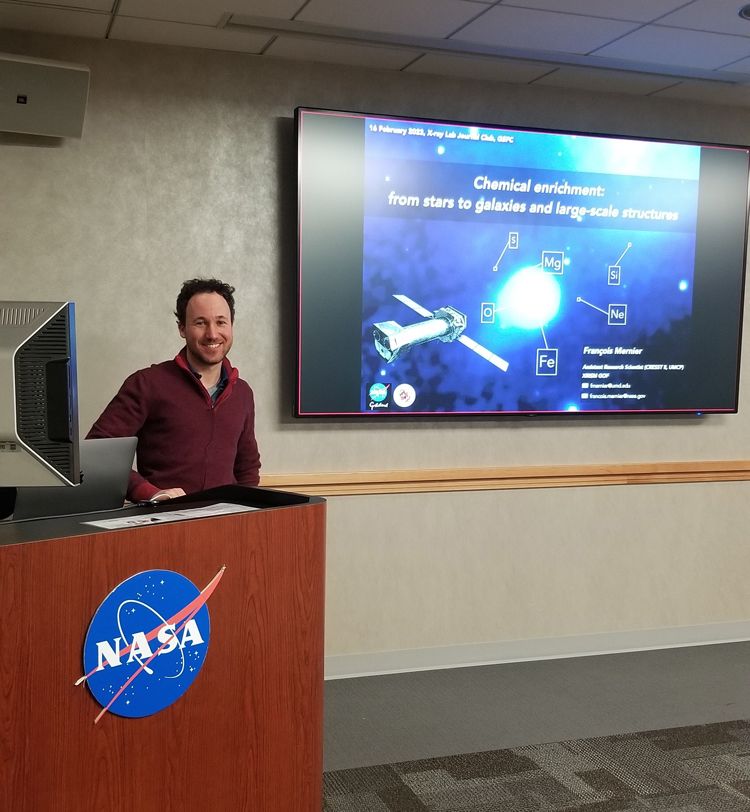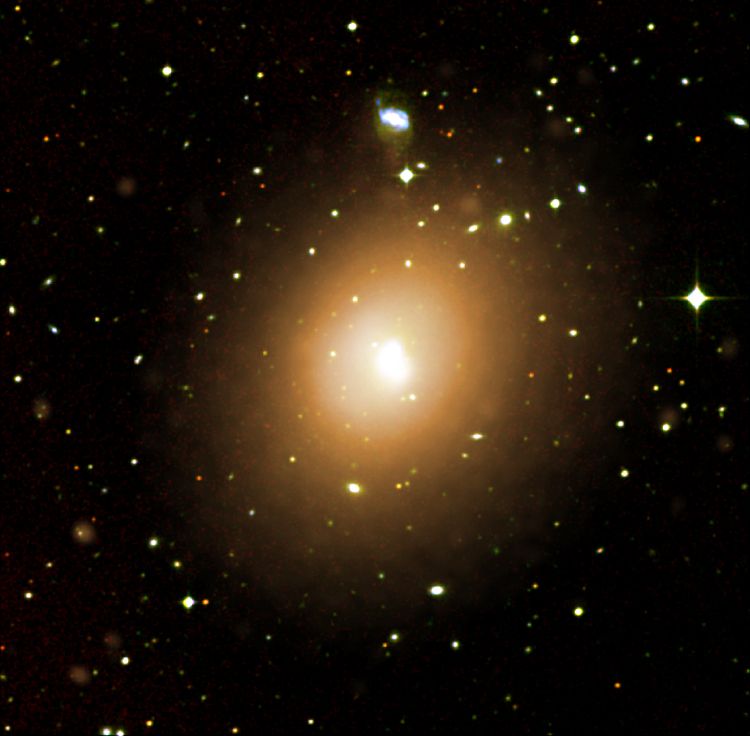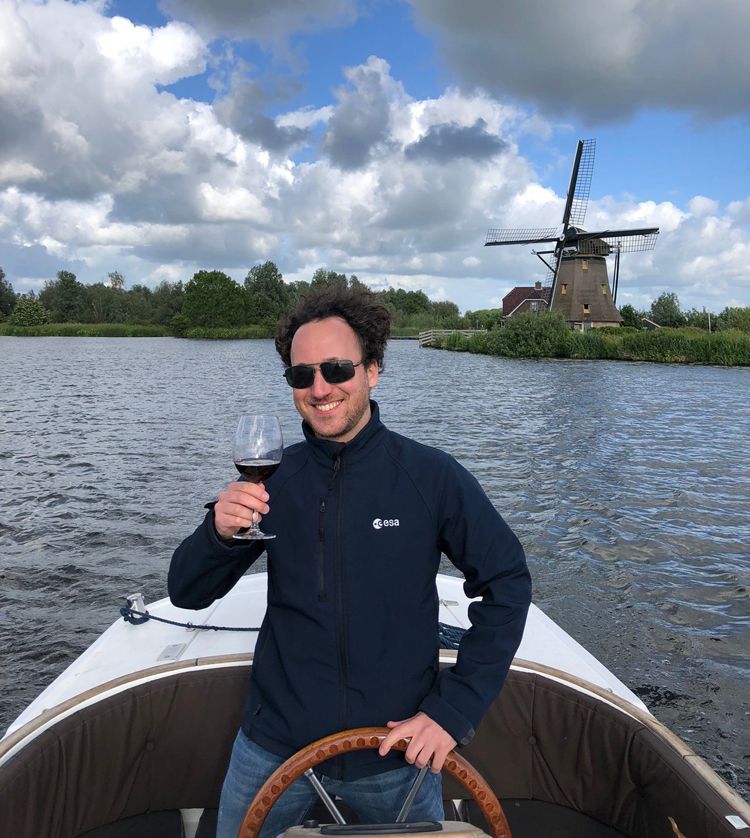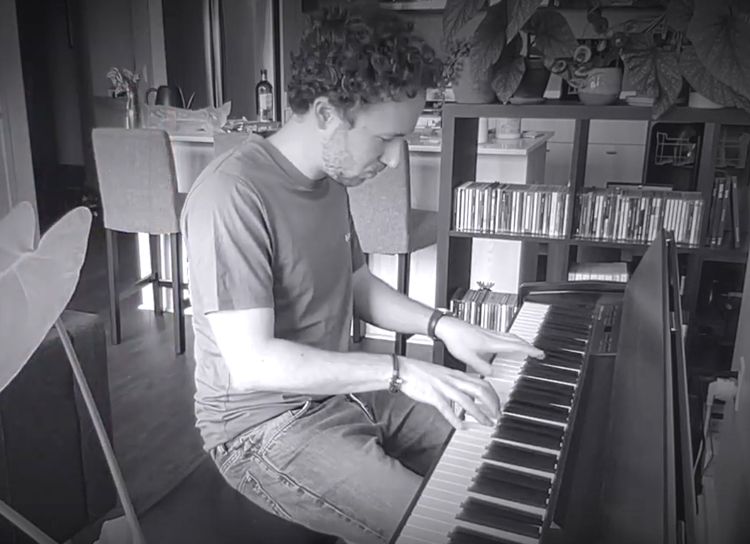Early Career Scientist Spotlight
Dr. Francois Mernier (he/him)
Observational Astronomer
X-ray Astrophysics Laboratory (662)
What science questions do you investigate?
The big topic that has always fascinated me is that of clusters of galaxies being chemically enriched by stars and supernovae. When we look at clusters (and groups) of galaxies through an X-ray telescope, we see a hot gas (107-8 K) that pervades the entire cluster volume. This intracluster medium, in which galaxies are literally swimming, accounts for about 80% of the total “visible” (i.e. non-“dark”) matter. More than stars, planets, and galaxies, the visible matter of our Universe is thus made of this gas, which moves, collides, and assembles into large-scale structures as we see them today. Given its cosmological origin, it would be common sense to picture this gas as pristine – i.e., containing only H and He. However, X-ray spectroscopy reveals the presence of many emission lines from many heavier chemical elements (O, Ne, Mg, Si, Si, Fe, Ni, etc.). Given that these heavier elements can only be created in the burning core of dying stars (remember: “We’re made of staff stuff”, as Carl Sagan used to say!), this is a truly spectacular result: stars and supernovae in galaxies must have created a huge amount of their end-of-life products before ejecting them way outside their galaxy hosts!
When, in cosmic history, did this massive epoch of enrichment happen? Is it a continuous process that is still happening as we speak, or did the bulk of these elements become released at once a long, long time ago? Also, how did these metals manage to travel hundreds of thousands of light-years away from galaxies and mix so thoroughly in the hot intracluster medium?
These are essentially the burning questions driving my science. The past generation of X-ray observatories (Chandra, XMM-Newton) allowed us to investigate many of these questions in great details (e.g., what are the chemical abundance of these elements in this hot gas, and how and where are they distributed?). However, the upcoming generation of high-resolution X-ray spectrometers – starting with the Resolve instrument onboard NASA’s X-Ray Imagining and Spectroscopy Mission (XRISM) – will dramatically transform our knowledge in this field!

Credit: D. R. Sadaula
Tell us about the research projects you are currently working on.
Part of my current work is to prepare the General Observing phase of the XRISM mission, which will be starting this summer. We welcome all your proposals and ideas, by the way!
In my own research time, I’m currently working on predicting how the Line Emission Mapper (LEM), an ambitious X-ray Probe Mission concept recently submitted to NASA, will answer the above questions about chemical enrichment at play in clusters and groups of galaxies. To do so, I base my work on a on a fake galaxy cluster seen in a large cosmological simulation as part of the Dianoga project. I then simulate how such a cluster would look like through the LEM detector. Compared to the “real” values we know from its cosmological simulation, will the mock LEM X-ray spectra of this cluster deliver accurate information about its chemical abundances? Spoiler alert: while XRISM is already about to boost our knowledge on these questions, LEM will push our understanding of large-scale enrichment to a next level (actually, several next levels)!

Credit: F. Mernier
What does a typical day at work look like for you?
Each day is very different from another. This is one of the reasons why I love this job! For example, I could very well spend my Monday being involved in XRISM activities (writing documentation, helping users, and learning a lot myself too!), then spend my Tuesday working on my own research, then prepare an oral presentation, a proposal, or any other scientific communication on a Wednesday, read and/or review papers on a Thursday, and collaborate with other scientists on LEM on a Friday. But, of course my activities vary from week to week. Some parts of the year are filled with hot XRISM or LEM actuality, some others are more suitable for creativity, new ideas, and personal research.

Credit: N. Islam
What was your first big research achievement?
My first big research achievement was probably a series of two papers I wrote during my graduate studies in 2016, linking the physics of stars and supernovae to the actual chemical composition of the intergalactic gas at megaparsec scales. These two papers (available here and here) are based on a simple idea that considers the following facts:
(i) The amount of chemical elements produced by supernovae highly depends on the physics of their progenitors (initial mass, explosion mechanism, etc.),
(ii) The hot gas pervading galaxy clusters contains the end-products of billions of supernovae,
(ii) It is relatively easy to measure accurate chemical abundances in intracluster gas because it is optically thin and in ionization equilibrium.
As such, we can use these large-scale chemical abundances to trace backwards and determine which stars have exploded in galaxies, and how they did so. In other words, let’s better understand stars and supernovae by looking at their chemical signatures in clusters of galaxies! A concrete example is the mysterious nature of Type Ia supernovae. These violent stellar explosions, showing no trace of hydrogen in their spectra and being used as cosmic distance ladders by cosmologists to measure the expansion of the Universe, are thought to be triggered by a white dwarf (i.e., a dead low-mass star, which our Sun will turn into about 4 billion years from now) after reaching a critical mass. But what happens exactly? Does a white dwarf reach its critical mass by slowly accreting the material from another star? Or are Type Ia supernovae the result of the violent collision between two white dwarfs? Looking at the chemical abundances that these supernovae left behind within the hot gas of galaxy clusters, my results showed that both mechanisms should co-exist in nature.

Credit: B. Dirkers
What advice would you give your younger self?
I would give my younger self two pieces of advice. First, be confident. Don’t hesitate to go talk to experts, even if they are more senior. This may be easier to say than to do, especially for people who are introverted and/or who suffer from imposter syndrome (which used to be my case when I started my graduate studies… sometimes even nowadays as well!). Second, be even more curious! Get out of your scientific comfort zone, embrace your interests, and explore various topics, even those that are not directly related to your PhD project! I believe that curiosity is THE most important quality for an astronomer. All the other necessary qualities (motivation, perseverance, knowledge of math and physics) result from great curiosity, in one way or another.

Credit: A. Tümer
What do you like to do in your free time?
Perhaps my biggest hobby (outside of astronomy of course!) is music. I particularly love to play piano. I spend quite a lot of my free time learning pop/rock songs that I like and making covers out of them. I even have a YouTube channel where I keep track of all of them: https://www.youtube.com/superwallon. It isn’t very professional of course, and there’s a lot of room for improvement, but I’m having lots of fun learning, recording, and sharing songs with interested people! Another one of my hobbies is sports. To play or to watch? Well, both. I love to play soccer (I’ve been part of the Goddard Soccer League since last summer), I used to play fencing for many years before arriving to the US (I’d like to find a new club in the DMV), and I occasionally run, swim, and cycle. I also like to watch soccer and cycling.

Credit: F. Mernier
What are your future research interests and goals?
I’m still very focused on my current research, as there are still so many unanswered questions about chemical enrichment in the large-scale Universe! In contrast with other galaxy cluster topics in the X-ray band (gas velocity, thermodynamics, feedback mechanisms, etc.), the chemical enrichment field is still lacking significant manpower. Good news is that this gives me room to pursue my research without too much pressure or worries about potential over-competition (which can be sometimes overwhelming, especially for young researchers). However, I also feel a responsibility to make progress in this field, to keep it compelling, and to advocate for its importance in our understanding of large-scale structure assembly. I’d like to extend this field to multi-wavelength studies, to bring a coherent picture of chemical enrichment as a whole. This next step implies building a strong network of collaborators, which I hope to do over the upcoming months and years.
Biography
Home Town:
Brussels, Belgium
Undergraduate Degree:
M.Sc. Space Sciences, University of Liège, Belgium
Post-graduate Degrees:
Ph.D. Astrophysics, Leiden University, The Netherlands

Link to Dr. Mernier's GSFC Bio
